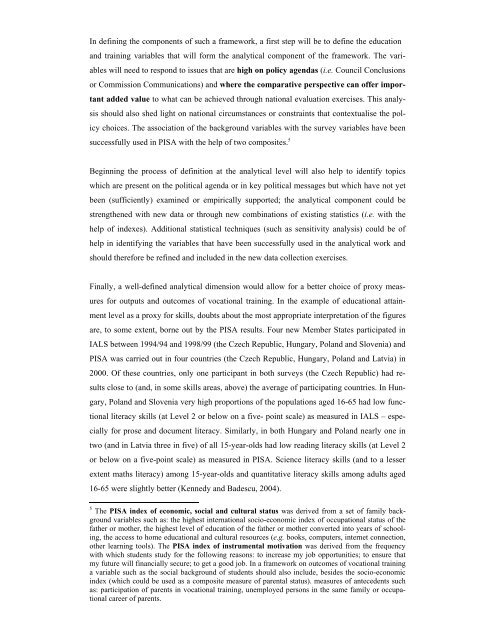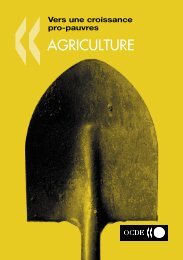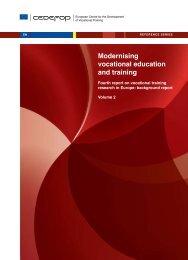measuring the outputs and outcomes of vocational training
measuring the outputs and outcomes of vocational training
measuring the outputs and outcomes of vocational training
Create successful ePaper yourself
Turn your PDF publications into a flip-book with our unique Google optimized e-Paper software.
In defining <strong>the</strong> components <strong>of</strong> such a framework, a first step will be to define <strong>the</strong> education<br />
<strong>and</strong> <strong>training</strong> variables that will form <strong>the</strong> analytical component <strong>of</strong> <strong>the</strong> framework. The variables<br />
will need to respond to issues that are high on policy agendas (i.e. Council Conclusions<br />
or Commission Communications) <strong>and</strong> where <strong>the</strong> comparative perspective can <strong>of</strong>fer important<br />
added value to what can be achieved through national evaluation exercises. This analysis<br />
should also shed light on national circumstances or constraints that contextualise <strong>the</strong> policy<br />
choices. The association <strong>of</strong> <strong>the</strong> background variables with <strong>the</strong> survey variables have been<br />
successfully used in PISA with <strong>the</strong> help <strong>of</strong> two composites. 5<br />
Beginning <strong>the</strong> process <strong>of</strong> definition at <strong>the</strong> analytical level will also help to identify topics<br />
which are present on <strong>the</strong> political agenda or in key political messages but which have not yet<br />
been (sufficiently) examined or empirically supported; <strong>the</strong> analytical component could be<br />
streng<strong>the</strong>ned with new data or through new combinations <strong>of</strong> existing statistics (i.e. with <strong>the</strong><br />
help <strong>of</strong> indexes). Additional statistical techniques (such as sensitivity analysis) could be <strong>of</strong><br />
help in identifying <strong>the</strong> variables that have been successfully used in <strong>the</strong> analytical work <strong>and</strong><br />
should <strong>the</strong>refore be refined <strong>and</strong> included in <strong>the</strong> new data collection exercises.<br />
Finally, a well-defined analytical dimension would allow for a better choice <strong>of</strong> proxy measures<br />
for <strong>outputs</strong> <strong>and</strong> <strong>outcomes</strong> <strong>of</strong> <strong>vocational</strong> <strong>training</strong>. In <strong>the</strong> example <strong>of</strong> educational attainment<br />
level as a proxy for skills, doubts about <strong>the</strong> most appropriate interpretation <strong>of</strong> <strong>the</strong> figures<br />
are, to some extent, borne out by <strong>the</strong> PISA results. Four new Member States participated in<br />
IALS between 1994/94 <strong>and</strong> 1998/99 (<strong>the</strong> Czech Republic, Hungary, Pol<strong>and</strong> <strong>and</strong> Slovenia) <strong>and</strong><br />
PISA was carried out in four countries (<strong>the</strong> Czech Republic, Hungary, Pol<strong>and</strong> <strong>and</strong> Latvia) in<br />
2000. Of <strong>the</strong>se countries, only one participant in both surveys (<strong>the</strong> Czech Republic) had results<br />
close to (<strong>and</strong>, in some skills areas, above) <strong>the</strong> average <strong>of</strong> participating countries. In Hungary,<br />
Pol<strong>and</strong> <strong>and</strong> Slovenia very high proportions <strong>of</strong> <strong>the</strong> populations aged 16-65 had low functional<br />
literacy skills (at Level 2 or below on a five- point scale) as measured in IALS – especially<br />
for prose <strong>and</strong> document literacy. Similarly, in both Hungary <strong>and</strong> Pol<strong>and</strong> nearly one in<br />
two (<strong>and</strong> in Latvia three in five) <strong>of</strong> all 15-year-olds had low reading literacy skills (at Level 2<br />
or below on a five-point scale) as measured in PISA. Science literacy skills (<strong>and</strong> to a lesser<br />
extent maths literacy) among 15-year-olds <strong>and</strong> quantitative literacy skills among adults aged<br />
16-65 were slightly better (Kennedy <strong>and</strong> Badescu, 2004).<br />
5 The PISA index <strong>of</strong> economic, social <strong>and</strong> cultural status was derived from a set <strong>of</strong> family background<br />
variables such as: <strong>the</strong> highest international socio-economic index <strong>of</strong> occupational status <strong>of</strong> <strong>the</strong><br />
fa<strong>the</strong>r or mo<strong>the</strong>r, <strong>the</strong> highest level <strong>of</strong> education <strong>of</strong> <strong>the</strong> fa<strong>the</strong>r or mo<strong>the</strong>r converted into years <strong>of</strong> schooling,<br />
<strong>the</strong> access to home educational <strong>and</strong> cultural resources (e.g. books, computers, internet connection,<br />
o<strong>the</strong>r learning tools). The PISA index <strong>of</strong> instrumental motivation was derived from <strong>the</strong> frequency<br />
with which students study for <strong>the</strong> following reasons: to increase my job opportunities; to ensure that<br />
my future will financially secure; to get a good job. In a framework on <strong>outcomes</strong> <strong>of</strong> <strong>vocational</strong> <strong>training</strong><br />
a variable such as <strong>the</strong> social background <strong>of</strong> students should also include, besides <strong>the</strong> socio-economic<br />
index (which could be used as a composite measure <strong>of</strong> parental status). measures <strong>of</strong> antecedents such<br />
as: participation <strong>of</strong> parents in <strong>vocational</strong> <strong>training</strong>, unemployed persons in <strong>the</strong> same family or occupational<br />
career <strong>of</strong> parents.








